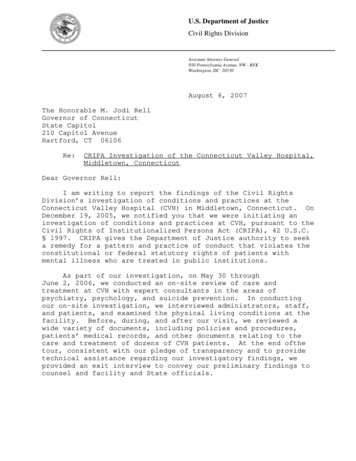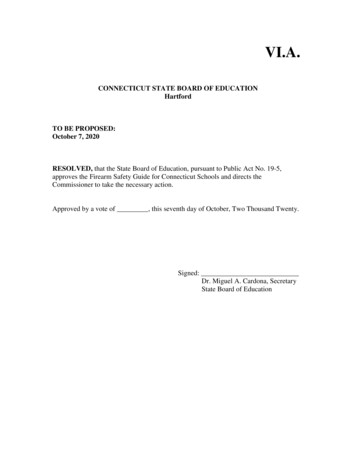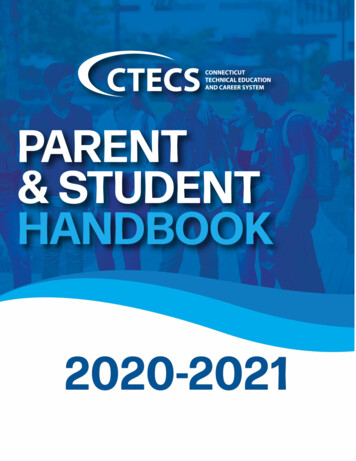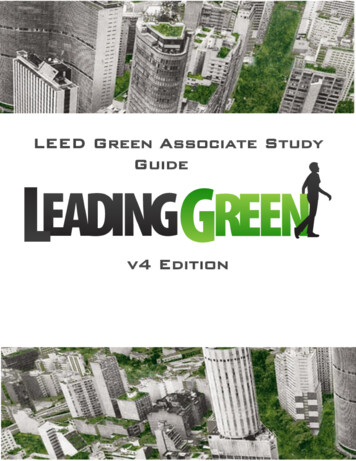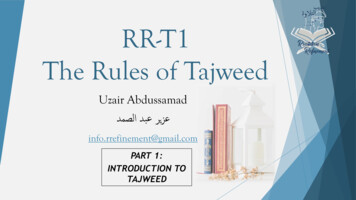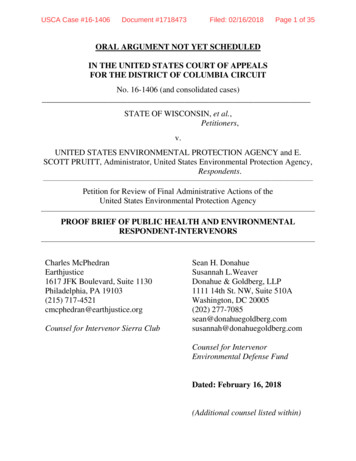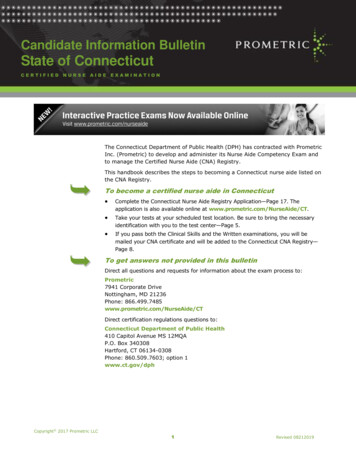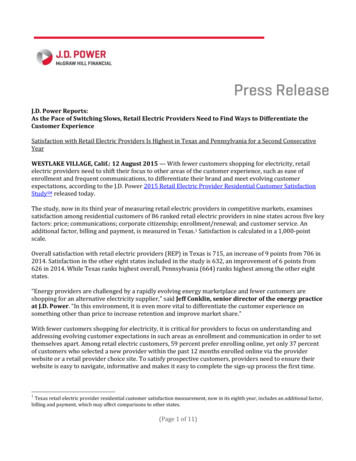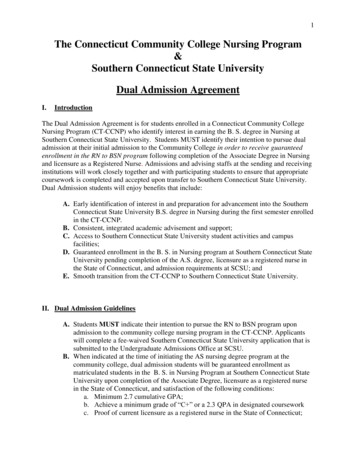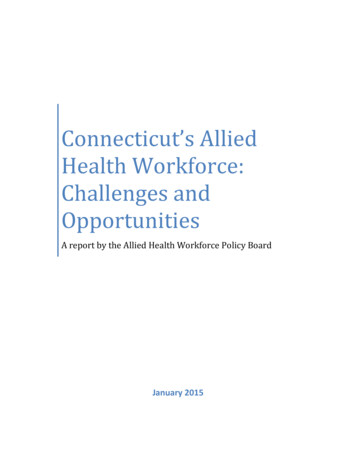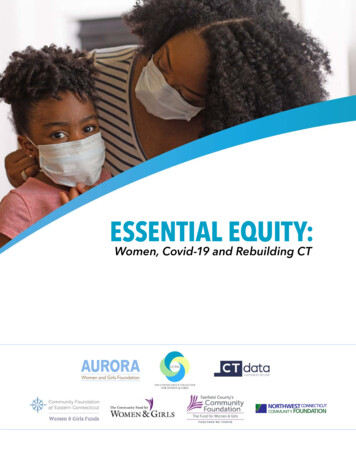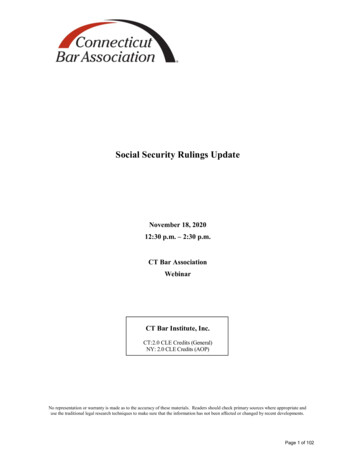
Transcription
Social Security Rulings UpdateNovember 18, 202012:30 p.m. – 2:30 p.m.CT Bar AssociationWebinarCT Bar Institute, Inc.CT:2.0 CLE Credits (General)NY: 2.0 CLE Credits (AOP)No representation or warranty is made as to the accuracy of these materials. Readers should check primary sources where appropriate anduse the traditional legal research techniques to make sure that the information has not been affected or changed by recent developments.Page 1 of 102
Table of ContentsLawyers’ Principles of Professionalism . 3Agenda . 6Faculty Biographies . 7Social Security Rulings – A Disability Advocate’s Resource for Hearings and Appeals . 8Page 2 of 102
Approved by the House of Delegates October 19, 2020LAWYERS’ PRINCIPLES OF PROFESSIONALISMAs a lawyer, I have dedicated myself to making our system of justice work fairly and efficientlyfor all. I am an officer of this Court and recognize the obligation I have to advance the rule oflaw and preserve and foster the integrity of the legal system. To this end, I commit myself notonly to observe the Connecticut Rules of Professional Conduct, but also conduct myself inaccordance with the following Principles of Professionalism when dealing with my clients,opposing parties, fellow counsel, self-represented parties, the Courts, and the general public.Civility:Civility and courtesy are the hallmarks of professionalism. As such, I will be courteous, polite, respectful, and civil, both in oral and in writtencommunications;I will refrain from using litigation or any other legal procedure to harass an opposingparty;I will not impute improper motives to my adversary unless clearly justified by the factsand essential to resolution of the issue;I will treat the representation of a client as the client’s transaction or dispute and not as adispute with my adversary;I will respond to all communications timely and respectfully and allow my adversary areasonable time to respond;I will avoid making groundless objections in the discovery process and workcooperatively to resolve those that are asserted with merit;I will agree to reasonable requests for extensions of time and for waiver of proceduralformalities when the legitimate interests of my client will not be adversely affected;I will try to consult with my adversary before scheduling depositions, meetings, orhearings, and I will cooperate with her when schedule changes are requested;When scheduled meetings, hearings, or depositions have to be canceled, I will notify myadversary and, if appropriate, the Court (or other tribunal) as early as possible and enlisttheir involvement in rescheduling; andI will not serve motions and pleadings at such time or in such manner as will unfairlylimit the other party’s opportunity to respond.Honesty:Honesty and truthfulness are critical to the integrity of the legal profession – they are core valuesthat must be observed at all times and they go hand in hand with my fiduciary duty. As such, I will not knowingly make untrue statements of fact or of law to my client, adversary orthe Court;I will honor my word;I will not maintain or assist in maintaining any cause of action or advancing any positionthat is false or unlawful;1Page 3 of 102
Approved by the House of Delegates October 19, 2020 I will withdraw voluntarily claims, defenses, or arguments when it becomes apparent thatthey do not have merit or are superfluous;I will not file frivolous motions or advance frivolous positions;When engaged in a transaction, I will make sure all involved are aware of changes I maketo documents and not conceal changes.Competency:Having the necessary ability, knowledge, and skill to effectively advise and advocate for aclient’s interests is critical to the lawyer’s function in their community. As such, I will keep myself current in the areas in which I practice, and, will associate with, orrefer my client to, counsel knowledgeable in another field of practice when necessary;I will maintain proficiency in those technological advances that are necessary for me tocompetently represent my clients.I will seek mentoring and guidance throughout my career in order to ensure that I act withdiligence and competency.Responsibility:I recognize that my client’s interests and the administration of justice in general are best servedwhen I work responsibly, effectively, and cooperatively with those with whom I interact. Assuch, Before dates for hearings or trials are set, or if that is not feasible, immediately after suchdates have been set, I will attempt to verify the availability of key participants andwitnesses so that I can promptly notify the Court (or other tribunal) and my adversary ofany likely problem;I will make every effort to agree with my adversary, as early as possible, on a voluntaryexchange of information and on a plan for discovery;I will attempt to resolve, by agreement, my objections to matters contained in myopponent's pleadings and discovery requests;I will be punctual in attending Court hearings, conferences, meetings, and depositions;I will refrain from excessive and abusive discovery, and I will comply with all reasonablediscovery requests;In civil matters, I will stipulate to facts as to which there is no genuine dispute;I will refrain from causing unreasonable delays;Where consistent with my client's interests, I will communicate with my adversary in aneffort to avoid needless controversial litigation and to resolve litigation that has actuallycommenced;While I must consider my client’s decision concerning the objectives of therepresentation, I nevertheless will counsel my client that a willingness to initiate orengage in settlement discussions is consistent with zealous and effective representation.2Page 4 of 102
Approved by the House of Delegates October 19, 2020Mentoring:I owe a duty to the legal profession to counsel less experienced lawyers on the practice of the lawand these Principles, and to seek mentoring myself. As such: I will exemplify through my behavior and teach through my words the importance ofcollegiality and ethical and civil behavior;I will emphasize the importance of providing clients with a high standard ofrepresentation through competency and the exercise of sound judgment;I will stress the role of our profession as a public service, to building and fostering therule of law;I will welcome requests for guidance and advice.Honor:I recognize the honor of the legal profession and will always act in a manner consistent with therespect, courtesy, and weight that it deserves. As such, I will be guided by what is best for my client and the interests of justice, not whatadvances my own financial interests;I will be a vigorous and zealous advocate on behalf of my client, but I recognize that, asan officer of the Court, excessive zeal may be detrimental to the interests of a properlyfunctioning system of justice;I will remember that, in addition to commitment to my client's cause, my responsibilitiesas a lawyer include a devotion to the public good;I will, as a member of a self-regulating profession, report violations of the Rules ofProfessional Conduct as required by those rules;I will protect the image of the legal profession in my daily activities and in the ways Icommunicate with the public;I will be mindful that the law is a learned profession and that among its desirable goalsare devotion to public service, improvement of administration of justice, and thecontribution of uncompensated time and civic influence on behalf of those persons whocannot afford adequate legal assistance; andI will support and advocate for fair and equal treatment under the law for all persons,regardless of race, color, ancestry, sex, pregnancy, religion, national origin, ethnicity,disability, status as a veteran, age, gender identity, gender expression or marital status,sexual orientation, or creed and will always conduct myself in such a way as to promoteequality and justice for all.Nothing in these Principles shall supersede, supplement, or in any way amend the Rules ofProfessional Conduct, alter existing standards of conduct against which a lawyer’s conduct mightbe judged, or become a basis for the imposition of any civil, criminal, or professional liability.3Page 5 of 102
Social Security Rulings Update (EDL201118)November 18, 202012:30 p.m. to 2:30 p.m.SpeakersJohn P. Spilka, Connecticut Legal Services, New BritainRussell D. Zimberlin, Zimberlin Law LLC, d or Superseded RulingsRulings Related to Specific ImpairmentsRulings Related to Past Relevant Work and Other WorkRulings Related to Residual Functional CapacityRulings Related to the Sequential EvaluationMiscellaneous RulingsRulings Related to Procedural Issues in Disability ClaimsChildren’s Disability RulingsPage 6 of 102
Faculty BiographiesJohn P. Spilka has been a legal aid attorney since 1974 and practices out of the New Britain office of ConnecticutLegal Services, Inc. He is employed as the Managing Attorney of the Disability Unit where he oversees the SocialSecurity and SSI disability work for his program. His practice primarily focuses on representing disabilityclaimants at administrative hearings and handling appeals at the Appeals Council and in Federal District Court.He has prepared resource materials and provided training on Social Security and SSI disability law for numerousCBA seminars. He is a graduate of Fairfield University and the University of Detroit, School of Law. He currentlyserves on the Executive Committee of the Disability Section of the CBA.Russell Zimberlin is an attorney with Zimberlin Law LLC where he represents claimants in Veterans Disability,Connecticut State Employee Disability Retirement, Social Security Disability/SSI, and ERISA/Non-ERISA basedLong-Term Disability Insurance plans. Mr. Zimberlin is admitted to practice in Connecticut and before UnitedStates District court for the District of Connecticut and the United States Court of Appeals for Veterans Claims.He also practices before the Department of Veterans Affairs and the Social Security Administration. Mr.Zimberlin is a member of the Hartford County Bar Association, Connecticut Bar Association, Manchester BarAssociation, and Tolland County Bar Association. He earned his B.S. degree from Temple University and hisJ.D. degree from New England Law. He currently serves as Chair for the Disability Section of the CBA.Page 7 of 102
CBA Training – November 18, 2020SOCIAL SECURITY RULINGS – A DISABILITY ADVOCATE’SRESOURCE FOR HEARINGS AND APPEALSPresented by: John P. Spilka, Esq., Connecticut Legal Services, Inc.Russell Zimberlin, Esq., Zimberlin Law, LLCWith the precipitous decline in the favorable decision rate at the ALJ hearing level in recentyears and the need to appeal more claims to the Appeals Council and District Court, it is importantthat SSI/SSDI advocates are familiar with the Commissioner’s Social Security Rulings. TheseRulings can help with the preparation of the legal strategy for a hearing. They can also provide thebasis for legal arguments raised on appeal. The Social Security Administration at all levels ofadjudication is bound to follow these Rulings.“We publish Social Security Rulings in the Federal Register under the authority of theSocial Security Commissioner. They are binding on all components of the Social SecurityAdministration. These rulings represent precedent final opinions and orders and statements ofpolicy and interpretations that we have adopted.” 20 CFR 402.35(b) (1).This seminar will include a discussion of some of the Rulings that can assist disabilityadvocates in their representation of SSI/SSDI claimants. Court decisions specifically referencingthe Rulings or addressing a topic in the Rulings are cited in this material. Some of the courtdecisions relate to a superseded Ruling but these decisions may have some value in analyzing thenew Ruling. In addition, there are some practice tips included.Please note that all of the Rulings referenced herein are not fully reproduced. You areencouraged to read the full Ruling to have the best understanding of the Commissioner’sstatements of policy and interpretations. The Commissioner has been very active rescinding orsuperseding Rulings in recent years. It would not be surprising if additional Rulings are rescindedor superseded.Property of Connecticut Legal Services, Inc. Do Not Reproduce without Permission.Page 8 of 102
TABLE OF CONTENTSPage3Rescinded or Superseded RulingsRulings Related to Specific Impairments4, 6Rulings Related to Past Relevant Work and Other Work4, 36Rulings Related to Residual Functional Capacity5, 49Rulings Related to the Sequential Evaluation5, 55Miscellaneous Rulings5, 61Rulings Related to Procedural Issues in Disability Claims6, 87Children’s Disability Rulings6, 90Property of Connecticut Legal Services, Inc. Do Not Reproduce without Permission.2Page 9 of 102
Rescinded or Superseded RulingsSSR 82-59 – Titles II and XVI: Failure to Follow Prescribed TreatmentThis Ruling has been replaced by SSR 18-3p.SSR 83-20 – Titles II and XVI: Onset of DisabilityThis Ruling has been replaced by SSR 18-1p.SSR 87-6 – The Role of Prescribed Treatment in the Evaluation of EpilepsyThis Ruling was rescinded by Federal Register Notice Vol. 82, No. 41, page 12485, effectiveMarch 3, 2017. See the epilepsy Listings that were revised on September 29, 2016.SSR 93-2p – Evaluation of Human Immunodeficiency Virus SyndromeSee: Listings 14.08, 114.08 in place of this Ruling.SSR 96-2p – Giving Controlling Weight to Treating Source Medical OpinionsSee: Fed. Reg. Vol. 82, p. 5845; see also 20 CFR 404.1527, 416.927 re law to be applied toapplications filed prior to March 27, 2017 and 20 CFR 404.1520c, 416.920c re law to be applied to applications filedon or after March 27, 2017.SSR 96-3p – Considering Allegations of Pain and Other Symptoms in DeterminingWhether a Medically Determinable Impairment Is SevereThis Ruling was rescinded effective June 14, 2018.SSR 96-4p – Symptoms, Medically Determinable Physical and Mental Impairments,and Exertional and Nonexertional LimitationsThis Ruling was rescinded effective June 14, 2018.SSR 96-5p – Medical Source Opinions on Issues Reserved to the CommissionerSee: Fed. Reg. Vol. 82, p. 5845; 20 CFR 404.1520c, 416.920c and 20 CFR 404.1527, 416.927.This Ruling was rescinded effective March 27, 2017.SSR 96-6p – Consideration Of Administrative Findings Of Fact By State AgencyMedical And Psychological Consultants And Other Program PhysicianAnd Psychologists At The Administrative Law Judge And AppealsCouncil Levels Of Administrative Review; Medical EquivalenceSee: Fed. Reg. Vol. 82, p. 5845; 20 CFR 404.1520c, 416.920c and 20 CFR 404.1527 416.927; seeSSR 17-2p re medical equivalence. This Ruling was rescinded effective March 17, 2017.Property of Connecticut Legal Services, Inc. Do Not Reproduce without Permission.3Page 10 of 102
SSR 96-7p – Evaluation of Symptoms in a Disability Claim: Assessing theCredibility of an Individual’s StatementsThis Ruling has been replaced by SSR 16-3p.SSR 01-2p ObesityThis Ruling has been replaced by SSR 19-2pSSR 06-3p – Considering Opinions and Other Evidence from Sources Who Are Not“Acceptable Medical Sources”; Considering Decisions On Disability ByOther Governmental and Nongovernmental AgenciesThis Ruling was rescinded effective March 27, 2017. See: 20 CFR 404.1527(f), 416.927(f) fordisability applications filed prior to March 27, 2017.Rulings Related To Specific ImpairmentsPageSSR 82-57 – Loss of SpeechSSR 03-1p – Post Polio SyndromeSSR 03-2p – Reflex Sympathetic DystrophySSR 06-1p – Tremolite Asbestos-Related ImpairmentsSSR 12-2p – FibromyalgiaSSR 13-2p – Alcoholism and Drug AddictionSSR 14-1p – Chronic Fatigue SyndromeSSR 14-2p – Diabetes MellitusSSR 14-3p – Endocrine Disorders Other Than DiabetesSSR 15-1p – Interstitial CystitisSSR 17-3p – Sickle Cell AnemiaSSR 19-2p – ObesitySSR 19-4p – Primary Headache Disorders (Including Migraines)66677913151818192529Rulings Related To Past Relevant Work And Other WorkSSR 82-40 – Past Relevant Work in a Foreign CountrySSR 82-41 – Work Skills and Their TransferabilitySSR 82-61 – Past Relevant Work as Actually or Generally PerformedSSR 82-62 – Capacity to Do Past Relevant WorkSSR 82-63 – Medical-Vocational Profiles Showing an Inability to MakeAdjustment to Other WorkSSR 83-10 – Determining Capability to Do Other WorkSSR 83-11 – Capability to Do Other Work – The Exertionally Based MedicalVocational Rules Met36373838383942Property of Connecticut Legal Services, Inc. Do Not Reproduce without Permission.4Page 11 of 102
PageSSR 83-12 – Capability to Do Other Work – The Medical-Vocational Rules as aFramework for Evaluating Exertional Limitations within a Rangeof Work or Between Ranges of WorkSSR 83-14 – Capability to Do Other Work – The Medical-Vocational Rules as aFramework for Evaluating a Combination of Exertional andNonexertional ImpairmentsSSR 85-15 – Capability to Do Other Work – The Medical-Vocational Rules as aFramework for Evaluating Solely Nonexertional ImpairmentsSSR 96-9p – RFC For Less Than Sedentary Work - See below under RFCSSR 00-4p – Use of Vocational Expert and Vocational Specialist Evidence andOther Reliable Occupational Information in Disability DecisionsSSR 05-1c – Whether Past Relevant Work Must Exist in Substantial Numbersin the National Economy424345474748Rulings Related To Residual Functional CapacitySSR 85-15 – Capability to Do Other Work – The Medical-Vocational Rules asa Framework for Evaluating Solely Nonexertional ImpairmentsSSR 85-16 – Residual Functional Capacity for Mental ImpairmentsSSR 96-8p – Assessing Residual Functional CapacitySSR 96-9p – Determining Capability to Do Other Work – Implications of aResidual Functional Capacity for Less Than a Full Range OfSedentary Work49495052Rulings Related To The Sequential EvaluationSSR 85-28 – Medical Impairments That Are Not SevereSSR 16-3p – Evaluation of Symptoms in Disability ClaimsSSR 17-2p – Evidence Needed by Adjudicators at the Hearings and AppealsCouncil Levels of the Administrative Review Process to MakeFindings about Medical Equivalence555560Miscellaneous RulingsSSR 94-1c – Illegal Activity as Substantial Gainful ActivitySSR 11-2p – Documenting and Evaluating Disability in Young AdultsSSR 17-4p – Responsibility for Developing Written EvidenceSSR 18-1p – Determining Established Onset Date in Disability ClaimsSSR 18-3p – Failure to Follow Prescribed TreatmentSSR 20-1p – How We Determine an Individual’s Education Category616164697584Property of Connecticut Legal Services, Inc. Do Not Reproduce without Permission.5Page 12 of 102
Rulings Related Procedural Issues In Disability ClaimsPageSSR 91-5p – Mental Incapacity and Good Cause for Missing the Deadline toRequest ReviewSSR 11-1p – Procedures for Handling Requests to File Subsequent Applicationsfor Disability BenefitsSSR 13-1p – Allegations of Unfairness, Prejudice, Partiality, Bias, Misconduct orDiscriminationSSR 13-3p – Appeal of an Initial Medical Disability Cessation Determination orDecisionSSR 17-1p – Reopening Based on Error on The Face of the EvidenceSSR 19-1p – Titles II and XVI: Effect of the Decision in Lucia v. Securities andExchange Commission (SEC) on Cases Pending at the AppealsCouncil878788898989Children’s Disability RulingsSSR 98-1p – Determining Medical Equivalence in Childhood Disability ClaimsWhen a Child Has Marked Limitations in Cognition and Speech90SSR 09-1p – Determining Childhood Disability under the Functional EquivalenceRule – The “Whole Child” Approach90SSR 09-2p – Documenting a Child’s Impairment Related Limitations91SSR 09-3p – Acquiring and Using Information92SSR 09-4p – Attending and Completing Tasks92SSR 09-5p – Interacting and Relating with Others93SSR 09-6p – Moving About and Manipulating Objects93SSR 09-7p – Caring for Yourself93SSR 09-8p – Health and Physical Well-Being94Rulings Related To Specific ImpairmentsSSR 82-57 – Loss of SpeechOrdinarily, when an individual's impairment prevents effective speech, the loss of function is sufficientlysevere so that an allowance under Listing 2.09 is justified on the basis of medical considerations alone, unless such afinding is rebutted by work activity. To speak effectively, an individual must be able to produce speech that can beheard, understood, and sustained well enough to permit useful communication in social and vocational settings.These criteria are applicable to the production of speech whether by natural function of the voice mechanism or bythe use of a prosthetic device.SSR 03-1p – Post Polio SyndromeComment: This ruling will not have much application with the passage of time because fewer peoplecontracted polio after the 1950s.SSR 03-2p – Reflex Sympathetic Dystrophy/Complex Regional Pain SyndromeProperty of Connecticut Legal Services, Inc. Do Not Reproduce without Permission.6Page 13 of 102
RSDS/CRPS are terms used to describe a constellation of symptoms and signs that may occur following aninjury to bone or soft tissue. The precipitating injury may be so minor that the individual does not even recallsustaining an injury. Other potential precipitants suggested by the medical literature include, but are not limited to,surgical procedures, drug exposure, stroke with hemiplegia, and cervical spondylosis.RSDS/CRPS is a chronic pain syndrome most often resulting from trauma to a single extremity. It can alsoresult from diseases, surgery, or injury affecting other parts of the body. Even a minor injury can triggerRSDS/CRPS. The most common acute clinical manifestations include complaints of intense pain and findingsindicative of autonomic dysfunction at the site of the precipitating trauma. Later, spontaneously occurring pain maybe associated with abnormalities in the affected region involving the skin, subcutaneous tissue, and bone. It ischaracteristic of this syndrome that the degree of pain reported is out of proportion to the severity of the injurysustained by the individual. When left untreated, the signs and symptoms of the disorder may worsen over time.Blodgett v. Comm’r of SSA, 3:16-cv-2110, (D. Conn. Jan. 24, 2018) (JAM) (unreported decision).Thiscase was remanded because, inter alia, the ALJ failed to consider SSR 03-2p in light of the claimant’s pain.Pensiero v. Saul, 2019 WL 6271265 (D.Conn. Nov. 25, 2019) (WIG). The court remanded this casebecause the ALJ failed to evaluate the claimant’s pain under SSR 03-2p.SSR 06-1p – Tremolite Asbestos-Related ImpairmentsThis Ruling explains how tremolite asbestos-related impairments are evaluated under the sequentialevaluation process.SSR 12-2p – FibromyalgiaProperty of Connecticut Legal Services, Inc. Do Not Reproduce without Permission.7Page 14 of 102
Generally, a person can establish that he or she has an MDI of FM by providing evidence from anacceptable medical source.[3] A licensed physician (a medical or osteopathic doctor) is the only acceptable medicalsource who can provide such evidence. We cannot rely upon the physician's diagnosis alone. The evidence mustdocument that the physician reviewed the person's medical history and conducted a physical exam. We will reviewthe physician's treatment notes to see if they are consistent with the diagnosis of FM, determine whether the person'ssymptoms have improved, worsened, or remained stable over time, and establish the physician's assessment overtime of the person's physical strength and functional abilities.Two ways in which to document fibromyalgia include:The 1990 ACR Criteria for the Classification of Fibromyalgia. Based on these criteria, we may find that aperson has an MDI of FM if he or she has all three of the following:1. A history of widespread pain—that is, pain in all quadrants of the body (the right and left sides of the body,both above and below the waist) and axial skeletal pain (the cervical spine, anterior chest, thoracic spine, or lowback)—that has persisted (or that persisted) for at least 3 months. The pain may fluctuate in intensity and may notalways be present.2. At least 11 positive tender points on physical examination (see diagram below). The positive tender pointsmust be found bilaterally (on the left and right sides of the body) and both above and below the waist. a. The 18 tender point sites are located on each side of the body at the:Occiput (base of the skull);Low cervical spine (back and side of the neck); Trapezius muscle (shoulder);Supraspinatus muscle (near the shoulder blade); Second rib (top of the rib cage near the sternum or breastbone);Lateral epicondyle (outer aspect of the elbow);Gluteal (top of the buttock);Greater trochanter (below the hip); andInner aspect of the knee.b. In testing the tender-point sites,[6] the physician should perform digital palpation with an approximate forceof 9 pounds (approximately the amount of pressure needed to blanch the thumbnail of the examiner). The physicianconsiders a tender point to be positive if the person experiences any pain when applying this amount of pressure tothe site.3. Evidence that other disorders that could cause the symptoms or signs were excluded. Other physical andmental disorders may have symptoms or signs that are the same or similar to those resulting from FM.[7] Therefore,it is common in cases involving FM to find evidence of examinations and testing that rule out other disorders thatcould account for the person's symptoms and signs. Laboratory testing may include imaging and other laboratorytests (for example, complete blood counts, erythrocyte sedimentation rate, anti-nuclear antibody, thyroid function,and rheumatoid factor).The 2010 ACR Preliminary Diagnostic Criteria. Based on these criteria, we may find that a person has anMDI of FM if he or she has all three of the following criteria[8]:1. A history of widespread pain (see section II.A.1.);2. Repeated manifestations of six or more FM symptoms, signs,[9] or co-occurring conditions,[10] especiallymanifestations of fatigue, cognitive or memory problems (“fibro fog”), waking unrefreshed,[11] depression, anxietydisorder, or irritable bowel syndrome; and3. Evidence that other disorders that could cause these repeated manifestations of symptoms, signs, or cooccurring conditions were excluded (see section II.A.3.).Property of Connecticut Legal Services, Inc. Do Not Reproduce without Permission.8Page 15 of 102
Footnote 9: Symptoms and signs that may be considered include the “(s)omatic symptoms” referred to inTable No. 4, “Fibromyalgia diagnostic criteria,” in the 2010 ACR Preliminary Diagnostic Criteria. We considersome of the “somatic symptoms” listed in Table No. 4 to be “signs” under 20 C.F.R. 404.1528(b) and 416.928(b).These “somatic symptoms” include muscle pain, irritable bowel syndrome, fatigue or tiredness, thinking orremembering problems, muscle weakness, headache, pain or cramps in the abdomen, numbness or tingling,dizziness, insomnia, depression, constipation, pain in the upper abdomen, nausea, nervousness, chest pain, blurredvision, fever, diarrhea, dry mouth, itching, wheezing, Raynaud's phenomenon, hives or welts, ringing in the ears,vomiting, heartburn, oral ulcers, loss of taste, change in taste, seizures, dry eyes, shortness of breath, loss of appetite,rash, sun sensitivity, hearing difficulties, easy bruising, hair loss, frequent urination, or bladder spasms.Footnote 10: Some co-occurring conditions that may be considered are referred to in Table No. 4,“Fibromyalgia diagnostic criteria,” in the 2010 ACR Preliminary Diagnostic Criteria as “somatic symptoms,” suchas irritable bowel syndrome or depression. Other co-occurring conditions, which are not listed in Table No. 4, mayalso be considered, such as anxiety disorder, chronic fatigue syndrome, irritable bladder syndrome, interstitialcystitis, temporomandibular joint disorder, gastroesophageal reflux disorder, migraine, or restless leg syndrome.Green-Younger v. Barnhart, 335 F.3d 99 (2d Cir. 2003). The seminal fibromyalgia case in the Circuit.Crossman v. Astrue, 783 F. Supp. 2d 300 (D.Conn. 2010) (MRK). This case relies upon Green-Younger v.Barnhart, 335 F.3d 99 (2d Cir. 2003) to reject the ALJ’s analysis of the claimant’s fibromyalgia.D’Auria v. Saul, 3:19-cv-108 (D.Conn. Jan. 23, 2020) (SALM) (unreported). The ALJ erred in failing torecognize the waxing and waning nature of FMS as set forth in SSR 12-2p.Daniel E., Jr. v. Saul, (D.Md. Apr. 6, 2020), 2020 WL 1675960.Sherteeke’o B. V. Saul, (D.Md. Mar. 26, 2020), 2020 WL 1491350.DeCepeda v. Berryhill, (D.Mass. Aug. 6, 2018), 2018 WL 3748170. The court noted that there are two setsof criteria for making a fibromyalgia diagnoses under SSR 12-2p.Practice Tip: Since a characteristic of FMS is that the symptoms can wax and wane, it is important to askthe claimant if they have good days and bad days, the frequency of these days, and how a good and bad day isdescribed with regard to symptoms and functional activity.SSR 13-2p – Alcoholism and Drug AddictionSelected excerpts from the ruling:- Sections 223(d)(2)(C) and 1614(a)(3)(J) of the Social Security Act (Act) provide that a claimant “shall notbe considered to be disabled * * * if alcoholism or drug addiction would * * * be a contributing factor material tothe Commissioner's determination that the individual is disabled.”- All adjudicators must provide sufficient information in their determination or decision that explains therationale supporting their determination of the materiality of DAA so that a subsequent reviewer
He also practices before the Department of Veterans Affairs and the Social Security Administration. Mr. Zimberlin is a member of the Hartford County Bar Association, Connecticut Bar Association, Manchester Bar Association, and Tolland County Bar Association. He earned his B.S. degree from Temple University and his J.D. degree from New England Law.
